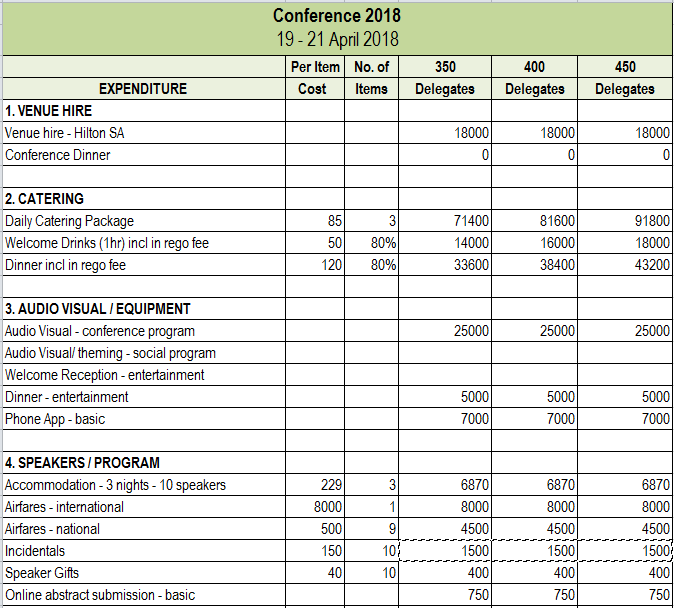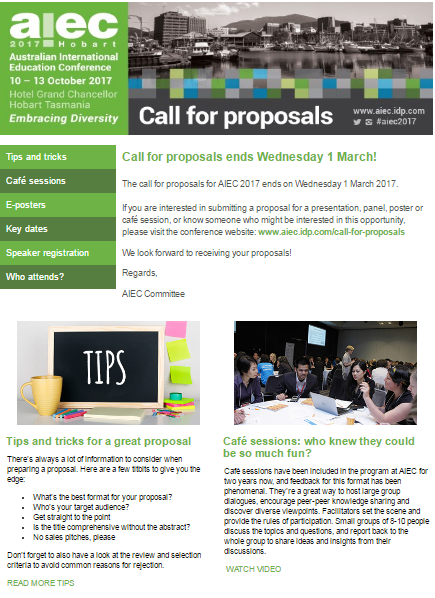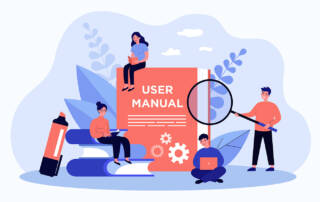The top 5 conference planning tools you can’t do without
Every PCO worth their salt will have these top 5 conference planning tools up their sleeve.
Every profession has its own industry specific tools needed to get the job done. A builder is nothing without a hammer, nails or saw, just as a doctor can’t get by without a stethoscope, thermometer or tongue depressor.
1. A Conference Budget
A budget is the a key tool for planning a conference. Outlining projected income and expenditure it’s a valuable guide for key decision making.
-
Identify your financial objectives at the start– do you want to break even or make a profit. If a profit, what is your target?
-
Create a flexible budget with comparative costings for minimum, mid and maximum numbers
-
Add in contingency cost for any unforeseen expenditures, circumstances or prices hikes
-
With income, err on the side of caution (especially with new conferences). Estimate a higher percentage of cheaper early bird ticket sales. Remember, percentage projections are adaptable when actual registration data comes in
-
And, don’t forget to account in the budget for tax in both income and expenditure

Your conference budget needs to account for different attendee scenarios.
2. A Critical Path
While listed second, the critical path really is equally important as the budget. It’s an invaluable planning tool that ensures nothing gets forgotten.
The critical path should be reviewed at each planning meeting.
3. Online registration and call for submission software
- all relevant contact details
- ticket purchases
- special event bookings
- reserve accommodation
- note special needs, and
- collect payments
Call for submission software needs to support the full submission, judging and selection process. Once again automatic confirmations and easy to use systems are paramount.
4. A Marketing Plan
This is where a multi-faceted marketing strategy comes in handy. Your conference marketing plan needs to incorporate digital technology, print materials, PR and advertising.
-
A marketing database: a database of your target audience. This can include pas conference attendees, association members or industry groups
-
A conference website: the main information portal for your conference. It needs to be updated with all relevant content
-
Email marketing software: Email marketing is a prime conference marketing tactic. You need email marketing software able to support multiple campaigns. This includes templates for easy design, analytical tools and list segmentation capabilities

Email marketing software should be in your conference planning toolbox.
5. A Smart Phone App
While technically not a planning tool – a conference smart phone app is a great addition to a conference’s success. If the budget allows, it should be planned for.
-
store important conference documents such as the conference program and delegate lists
-
connect attendees via meeting planners and invitation requests
-
promote sponsors and exhibitors via logo placements, advertisements and exhibitor floor plans
-
list speaker bio, session details and abstract with added search capabilities
-
deliver real time evaluation and live update alerts

A conference app is a key communication tool.
Any conference organiser worth their credentials, not only need these five key planning tools, but they also to know how to use them with impact. It’s why each should be operated under proven processes and procedures.
When managed correctly, these tools will ease the full conference planning process.
Need help with your Conference?
Read More of Our Event Thoughts
- Think Business Events Partners with Hidden Disabilities Sunflower to Enhance Accessibility at EventsKim Stevenson2024-11-25T15:30:49+11:00
Think Business Events Partners with Hidden Disabilities Sunflower to Enhance Accessibility at Events
- How To Prepare When Attending Your First ConferenceKim Stevenson2023-03-20T16:07:18+11:00
How To Prepare When Attending Your First Conference
- Kim’s trip to Geneva and the IAPCO EDGE SeminarKim Stevenson2023-01-27T15:19:43+11:00
Kim’s trip to Geneva and the IAPCO EDGE Seminar
- We asked some of our team ‘What’s in your conference kit?’Kim Stevenson2022-11-21T14:46:55+11:00
We asked some of our team ‘What’s in your conference kit?’
- 6 important things to remember when organising an international conferenceKim Stevenson2022-09-30T16:51:56+10:00
6 important things to remember when organising an international conference
- Case Study: The Australian Defence Science, Technology & Research SummitKim Stevenson2022-10-10T10:47:15+11:00
Case Study: The Australian Defence Science, Technology & Research Summit
- Case Study: The Australasian College of DermatologistsKim Stevenson2022-06-09T11:55:32+10:00
Case Study: The Australasian College of Dermatologists









